LPS corals – 40 popular species (with images) for reef aquariums
LPS corals have large calcareous skeletons with large fleshy polyps. They range in a broad range of care levels from very easy to some of the most difficult. Following are the most popular and colorful species for the reef aquarium.
- Acan Bowebanki - Acanthastrea bowerbanki
- Donut Coral - Acanthophyllia deshayesiana
- Flowerpot - Alveopora sp
- Australomussa - Australomussa rowleyensis
- Cup Coral - Balanophyllia sp
- Blastomussa wellsi
- Elegance Coral - Catalaphyllia sp
- Candy Cane Frag - Caulastrea furcata
- Sunset Plate Coral - Cycloseris sp
- Button Coral - Cynarina lacrymalis
- Purple People Eater - Cyphastrea sp
- Duncan - Duncanopsammia axifuga
- Chalice - Echinophyllia sp
- Hollywood Stunner Chalice - Echinopora lamellosa
- Hammer Coral - Euphyllia ancora
- Torch Coral - Euphyllia glabrescens
- Frogspawn Coral - Euphyllia divisa
- Moon Coral - Favia sp
- War Coral - Favites pentagona
- Plate Coral - Fungia sp
- Slipper Coral - Polyphyllia sp
- Tooth Coral - Galaxea sp
- Goniopora - Goniopora sp
- Long Tentacled Plate Coral - Heliofungia actiniformis
- Walking Dendro - Heteropsammia cochlea
- Leptastrea - Leptastrea sp
- Brain Coral - Lobophyllia sp
- Acan Lord - Acanthastrea lordhowensis
- Micromussa sp
- Cup Coral - Mycedium sp
- Pectinia sp
- Maze Coral - Platygyra sp
- Bubble Coral - Plerogyra sinuosa
- Scoly - Scolymia australis
- Brain Coral - Symphyllia
- Folded Brain Coral - Trachyphyllia geoffroyi
- Sun Coral - Tubastrea aurea
- Pipe Organ Coral - Tubipora musica
- Pagoda Coral - Turbinaria reniformis
Acan Bowebanki – Acanthastrea bowerbanki
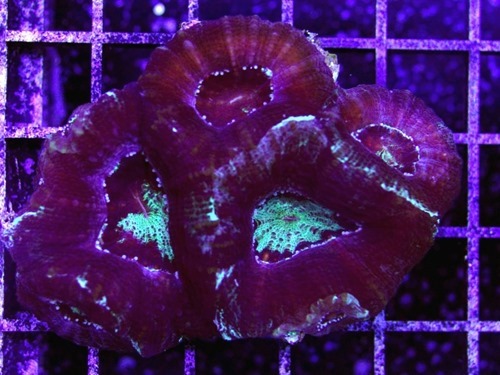
- Type: LPS
- Scientific name: Acanthastrea bowerbanki
- Common name: Acan Bowebanki
- Care level: Easy. This is a fairly hardy coral and will adapt to many conditions
- Lighting: Low to Moderate
- PAR: 100-150
- Water Flow: moderate non-laminar flow
- Feeding: small meaty foods 1-2 times a week
- Placement: Low on live rock or sandbed
- Aggressiveness: moderate. Short tentacles extended at night
Commonly referred to as ‘Acan Bowebanki’ these corals form small mounds in the aquarium as the polyps multiply. Acan bowerbanki are not as common in the hobby as the Acan Lords and have larger polyps.
Acans of all types are excellent candidates for moderately lit reef aquariums or low to moderately lit areas of reef aquariums with bright lighting.
Acans do best and will grow quicker if they are target fed meaty foods on occasion.
As is the case with all stony corals, attention needs to be paid to maintaining proper Calcium and Alkalinity levels in the reef tank for proper skeletal development as noted on the right.
Donut Coral – Acanthophyllia deshayesiana
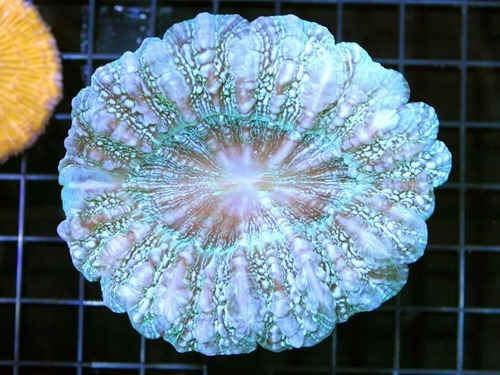
- Type: LPS
- Scientific name: Acanthophyllia deshayesiana
- Common name: Donut Coral
- Care level: Easy to moderate. Long-term survival is improved if the corals are fed meaty foods like mysis shrimp once a week
- Lighting: moderate intensity
- PAR: 100-125
- Water Flow: Low flow
- Feeding: small meaty foods 1-2 times weekly
- Placement: On sand bed
- Aggressiveness: Moderate. Has short tentacle reach but can expand in size and has fairly powerful sting
Acanthophyllia are usually referred to as Donut, Button or Meat coral. They are solitary fleshy single-polyp corals that do well in most home reef tanks.
This scientific name is new. They used to be classified as part of the Cynaria family but have recently been given their own classification. The easiest way to tell the difference is that Cynaria have translucent tissue that you can see the skeleton through while Acanthophyllia tissue is opaque.
Color is usually a green or red base but may include multiple colors such as purple, black, white or orange which often radiate from the center like spokes on a wheel. The color has a significant impact on the price with the most unusual or colorful specimens commanding the highest prices.
Acanthophyllia corals do well under low to moderate lighting and low water flow and should be placed on the sand bed. Too strong of lighting can easily bleach the coral, so err on the side of lower light levels.
Though primarily photosynthetic, feeding tentacles are extended at night and the coral will do best if feed small meaty foods such as mysis shrimp 1-2 times weekly when the tentacles are extended.
As is the case with all stony corals, attention needs to be paid to maintaining proper Calcium and Alkalinity levels in the reef tank for proper skeletal development as noted on the right.
Flowerpot – Alveopora sp
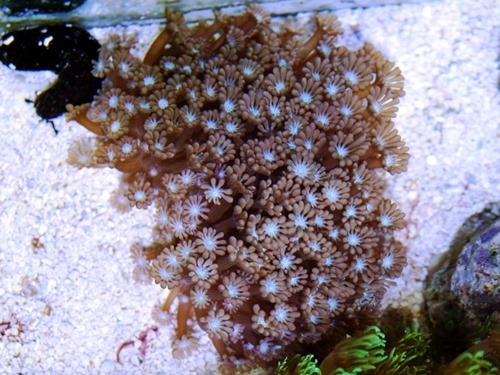
- Type: LPS
- Scientific name: Alveopora sp
- Common name: Flowerpot, Alveopora Daisy
- Care level: Intermediate. Alveopora is more hardy than the related Goniopora coral, but can still be somewhat delicate
- Lighting: moderate intensity
- PAR: 100-200
- Water Flow: moderate non-laminar flow
- Feeding: Reef-Roids, Reef Chili, Goniopora POwer and oyster eggs once a week
- Placement: On sand bed or low on rock work
- Aggressiveness: Moderate. Has moderate tentacle reach, but does not possess strong stinging capability. Can be in close proximity to other Alveopora or Goniopora corals
Alveopora look similar to Goniopora corals but can be differentiated by the fact that they have 12 tentacles on each polyp rather than 24 as is the case with Goniopora.
They may grow in a branching, encrusting, or mound shape depending on the species
Alveopora color is usually light tan to brown sometimes with white or green oral discs. While not usually brightly colored, their delicate-looking tentacles waving in the current can look quite attractive.
Target feeding is not required, but they will benefit from occasional feedings of fine filter feeder type foods such as Reef-Roids or oyster eggs.
Australomussa – Australomussa rowleyensis
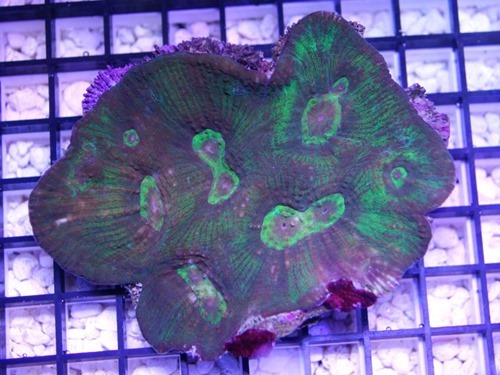
- Type: LPS
- Scientific name: Australomussa rowleyensis
- Common name: Australomussa
- Care level: Easy
- Lighting: low to moderate intensity
- PAR: 50-75
- Water Flow: low-moderate non-laminar flow
- Feeding:
- Placement: Low on rock work
- Aggressiveness: Low. Has short tentacle reach extended at night
Australomussa are fairly undemanding corals and will do well in most reef tanks. They grow in a flat or slightly domed fashion.
They like moderate lighting and will do well under T-05 or similar lighting. If placed under high intensity LED or Metal Halide, they should be placed low in the tank.
Water flow should be low to moderate.
They are photosynthetic and do not require target feeding, but they will take small meaty foods like mysis shrimp if offered at night when the feeding tentacles are present.
Cup Coral – Balanophyllia sp
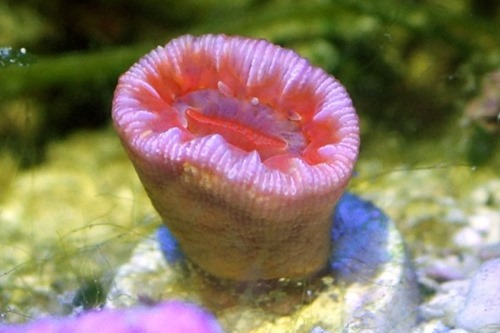
- Type: LPS
- Scientific name: Balanophyllia sp
- Common name: Cup Coral
- Care level: Moderate. Cup corals are hardy as long as their feeding requirements are met. It is due to the requirement to target feed the coral that it is listed as moderate
- Lighting: low intensity
- PAR: 25-100
- Water Flow: low flow
- Feeding: Mysis shrimp approximately 2-3 times a week
- Placement: On sand bed or low on rock work. Often placed under rock overhangs
- Aggressiveness: High. Has short tentacle reach, but strong stinging capability
Balanophyllia/ Cup corals are new in the hobby and still fairly rare.
They are solitary corals that means there is only one polyp. Some species may bud new polyps forming a small cluster and therefore look similar to Dendro or Sun Coral. With Cup corals, the polyp takes on an elongated oval shape as it grows and may form a figure 8.
Cup corals are not photosynthetic and therefore require frequent feeding of frozen or fresh meaty foods such as mysis shrimp, krill, or brine shrimp. They should be fed heavily at least twice a week or lighter feedings may be given up to every day.
Since they are not photosynthetic, they can be placed in an area of low light in the aquarium, preferably under a ledge or in a cave in an area of low water flow.
They should be placed on a rock which is then placed on the sand. If there is a danger, they will cover their tissue.
As is the case with all stony corals, attention needs to be paid to maintaining proper Calcium and Alkalinity levels in the reef tank for proper skeletal development as noted on the right.
Blastomussa wellsi
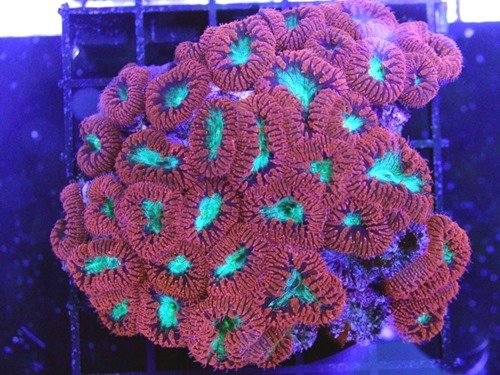
- Type: LPS
- Scientific name: Blastomussa wellsi
- Common name:
- Care level: Easy. Blastomussa corals are a fairly hearty coral once acclimated
- Lighting: low to moderate intensity
- PAR: 75-100
- Water Flow: moderate non-laminar flow
- Feeding: small meaty foods twice a week
- Placement: Low on rock work
- Aggressiveness: Low. Has short tentacle reach
Blastomussa wellsi coral has larger, more fleshy polyps than the similar Blastomussa merletti with which it is sometimes confused.
The polyps are most commonly colored brown, green, or red and usually some combination of those colors.
Blastomussa wellsi like low to moderate light and low water flow. If the lighting is too strong, they will not open fully. It is hard to give the coral too little light, so error on that side when introducing new specimens.
Blasto corals do not require feeding, but they can benefit from occasional feedings of small meaty foods when the polyps are open during the day.
Elegance Coral – Catalaphyllia sp
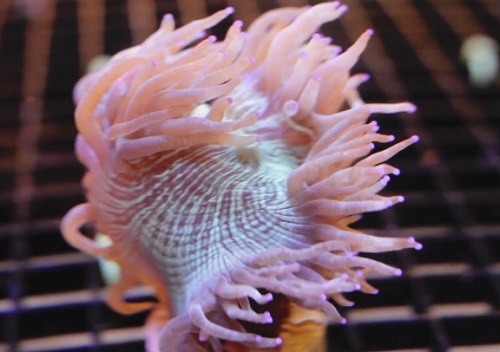
- Type: LPS
- Scientific name: Catalaphyllia sp
- Common name: Elegance Coral
- Care level: Intermediate. Most Elegance corals are fairly hardy once acclimated. Australian Elegance corals tend to be the hardiest
- Lighting: Moderate
- PAR: 150-200
- Water Flow: moderate non-laminar flow
- Feeding: Mysis and brine shrimp twice a week
- Placement: On sand bed
- Aggressiveness: High. Has long tentacle reach with powerful stinging capability, so it needs some space around it
Elegance Corals are very attractive and interesting corals.
Base color is usually a light pinkish tan color with bright iridescent green highlights through the oral disc. The tentacles may be tipped with white, pink, blue, or gold.
Elegance should generally be placed on the sand bed so that when the tentacles are extended and moving in the water current, they are not abraded by rocks. The skeleton of the coral is often cone-shaped and may be sunk into the sand to keep the coral upright.
Elegance corals should be fed small meaty foods a couple of times a week during the day when the tentacles are extended for optimum health.
Candy Cane Frag – Caulastrea furcata
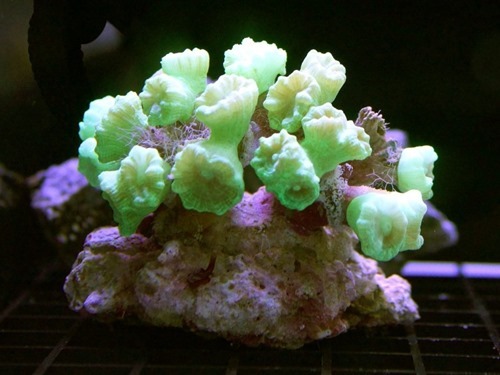
- Type: LPS
- Scientific name: Caulastrea furcata
- Common name: Candy Cane Frag
- Care level: Easy. Candy Cane corals are very hardy once acclimated and provided with the proper lighting and water flow
- Lighting: Moderate
- PAR: 100-150
- Water Flow: moderate non-laminar flow
- Feeding: small meaty foods 1-2 times weekly
- Placement: On sand bed or low on rock work
- Aggressiveness: Low. Has short tentacle reach, but will need some room for growth
Candy Cane coral polyps grow on branching tubular stalks. They are an easy coral to keep and fairly undemanding in their requirements for lighting and water flow.
Color may be one of a number of shades of green or may range from reddish-brown to fairly red. Centers may be a contrasting color.
They like moderate light and moderate water flow. Place higher in the tank if the lighting is fairly weak, such as under power compacts. Place towards the bottom of the tank or under an overhang if the lighting is intense such as with large Metal Halide lights or strong LED lighting.
It is not necessary to feed them, but they do benefit and will grow faster if they are fed on occasion with small meaty foods such as small mysis shrimp when their feeding tentacles are extended at night.
As is the case with all stony corals, attention needs to be paid to maintaining proper Calcium and Alkalinity levels in the reef tank for proper skeletal development as noted on the right.
Sunset Plate Coral – Cycloseris sp

- Type: LPS
- Scientific name: Cycloseris sp
- Common name: Sunset Plate Coral
- Care level: Easy. Fungia corals are not very demanding
- Lighting: Moderate to fairly intense
- PAR: 200
- Water Flow: moderate non-laminar flow
- Feeding: small meaty foods such as Mysis shrimp and Cyclopeeze twice a week
- Placement: On sand bed
- Aggressiveness: Moderate. Does not possess long sweeper tentacles, but may move about on the sand bed a bit, so needs a little space around it
In the wild Plate corals live on the sandy or rocky bottom in moderate to brightly lit locations. They are very undemanding in their requirements and will generally do well in most reef tank environments.
Colors are usually brown, green, or orange and may sometimes have stripes or contrasting colorful edges which are often purple. Tentacles are most commonly the same color as the polyp, but in some cases, the tentacles are a contrasting color. Other more rare colors include red. Color is generally the most intense under brighter lighting.
Plate corals are photosynthetic but will thrive better and grow faster if fed small meaty foods such as Mysis shrimp on occasion.
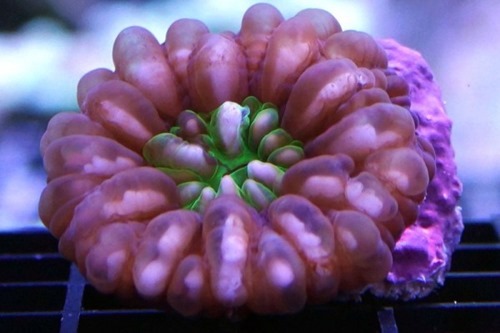
- Type: LPS
- Scientific name: Cynarina lacrymalis
- Common name: Button Coral
- Care level: Easy. Cynarina coral are undemanding and can do well in most reef tank setups
- Lighting: Moderate
- PAR: 150
- Water Flow: low non-laminar flow
- Feeding: meaty foods such as Mysis shrimp twice a week
- Placement: On sand bed
- Aggressiveness: Moderate. Has short tentacle reach, but can swell to twice its size, so will need some space around it
Cynarina corals are hardy, easy to care for corals, and a good choice for both beginner and advanced hobbyists.
They are a solitary polyp which grows in a round shape. They are one of the largest polyps found in the hobby.
They come in various colors including brown, green, and red, and are often translucent so that the skeleton is visible through the coral tissue.
Cynarina like moderate lighting and low water flow. Normal placement is on the sandbed.
They extend feeding tentacles at night and should be fed a meaty food on occasions such as mysis or brine shrimp.
Purple People Eater – Cyphastrea sp
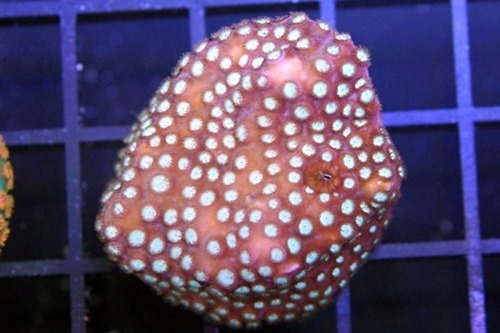
- Type: LPS
- Scientific name: Cyphastrea sp
- Common name: Purple People Eater
- Care level: Easy. Cyphastrea corals are hardy once acclimated and provided with the proper lighting and water flow
- Lighting: Low intensity
- PAR: 50-125
- Water Flow: moderate flow
- Feeding: System fed filter feeder type food 1-1 times a week
- Placement: low on rock work
- Aggressiveness: Low. Has no significant tentacle reach
Cyphastrea corals typically have a plating growth form and under the right conditions can grow fairly fast. The plating may be so thin that the substrate can still be seen through the coral.
There are many color variations of this coral including yellow, orange, pink, blue, teal, and blue often with contrasting colored polyps.
They like low to moderate light and moderate water flow. Colors are often best under lower light conditions.
Polyps are small, but will take very small foods typically offered to filter feeders.
As is the case with all stony corals, attention needs to be paid to maintaining proper Calcium and Alkalinity levels in the reef tank for proper skeletal development as noted on the right.
Duncan – Duncanopsammia axifuga
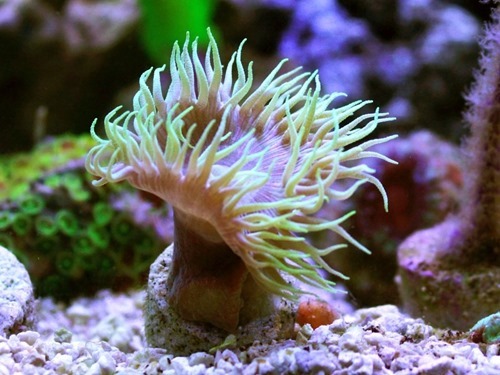
- Type: LPS
- Scientific name: Duncanopsammia axifuga
- Common name: Duncan
- Care level: Easy. Duncan corals are very hardy once acclimated and provided with the proper lighting and water flow
- Lighting: Low to Moderate
- PAR: 100-150
- Water Flow: moderate non-laminar flow
- Feeding:
- Placement: On sand bed or low on rock work. In brightly lit tanks, place under overhang to avoid giving too much light
- Aggressiveness: Medium. Has moderate tentacle reach and will need some room for growth
Duncan corals come from deeper waters and therefore prefer lower light levels. They are fairly new in the hobby. Color ranges from light brown to neon green. Duncan coral polyps grow on branching stalks.
They are an easy coral to keep and fairly undemanding in their requirements. Duncan corals are photosynthetic but will thrive better and grow faster if fed meaty foods such as mysis shrimp regularly which they greedily eat.
Chalice – Echinophyllia sp
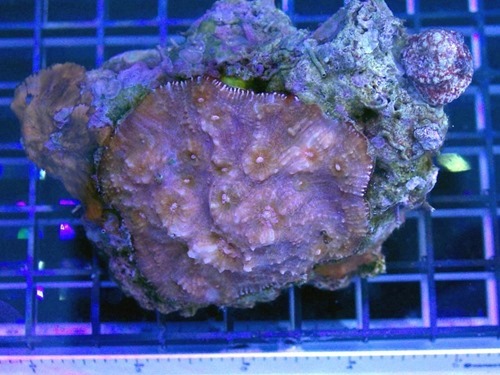
- Type: LPS
- Scientific name: Echinophyllia sp
- Common name: Chalice
- Care level: Moderate. Chalice coral are somewhat delicate and should be acclimated to new lighting carefully
- Lighting: low to moderate intensity
- PAR: 50-100
- Water Flow: moderate non-laminar flow
- Feeding:
- Placement: Low on rock work
- Aggressiveness: Moderate. Has moderate tentacle reach extended at night
Chalice corals like lower light levels. They can sometimes adapt to higher light levels, but this should be done carefully and overtime while watching their response. LED lighting in particular can stress Chalice corals if it is very intense. Chalice corals are kept under LED lighting at 100 PAR or less which is fairly weak light. They also do best with a higher kelvin (bluer) light.
Chalice corals like fairly low water flow and should be kept out of any strong direct water currents.
They do not require feeding but will take small meaty foods that are fed at night when their sweeper tentacles are out. Feeding will accelerate growth.
Hollywood Stunner Chalice – Echinopora lamellosa
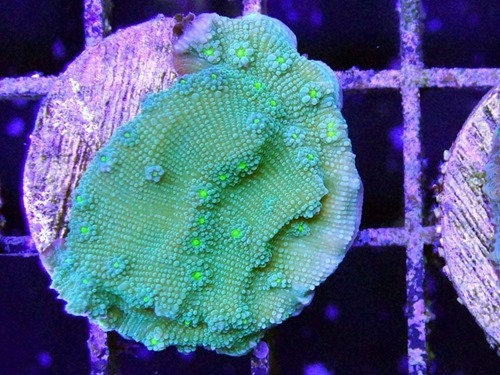
- Type: LPS
- Scientific name: Echinopora lamellosa
- Common name: Hollywood Stunner Chalice
- Care level: Moderate. Chalice coral are somewhat delicate and should be acclimated to new lighting carefully
- Lighting: low to moderate intensity
- PAR: 75-100
- Water Flow: moderate non-laminar flow
- Feeding: filter feeder foods twice a week
- Placement: Low on rock work
- Aggressiveness: Moderate. Has moderate tentacle reach extended at night
Chalice corals like lower light levels. They can sometimes adapt to higher light levels, but this should be done carefully and overtime while watching their response. LED lighting in particular can stress Chalice corals if it is very intense. Chalice corals are kept under LED lighting at 100 PAR or less which is fairly weak light. They also do best with a higher kelvin (bluer) light.
Chalice corals like fairly low water flow and should be kept out of any strong direct water currents.
They do not require feeding but will take small meaty foods that are fed at night when their sweeper tentacles are out. Feeding will accelerate growth.
Hammer Coral – Euphyllia ancora
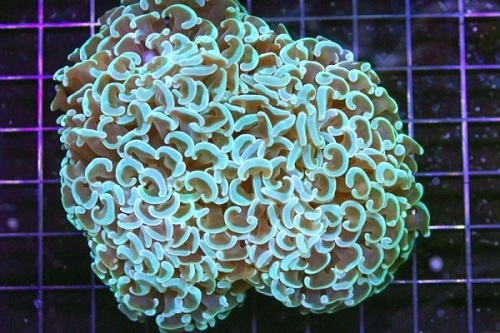
- Type: LPS
- Scientific name: Euphyllia ancora
- Common name: Hammer Coral
- Care level: Intermediate. Hammer corals can be touchy during acclimation, but once acclimated to a tank are usually quite hardy
- Lighting: Moderate to high with careful acclimation
- PAR: 200-250
- Water Flow: moderate non-laminar flow
- Feeding: meaty food 1-2 times a week
- Placement: On rock work
- Aggressiveness: High. Has long polyp reach with powerful stinging capability, so it needs some space around it
Hammer corals come in several different colors including green, yellow, orange, purple, and combinations of these colors.
Growth form can either be branching which forms heads on individual branches or it can be ‘wall’ type which means that it forms a single continuous wall of meandering skeletons as it grows. They can grow to be quite large, so the branching type can be pruned if necessary to control the size while the wall type cannot.
Hammer corals once they become established in the reef tank are quite hardy, but they can be moderately difficult to care for while they are adjusting to their new tank conditions.
Hammer corals are photosynthetic and will do fine with no specific target feeding, though they will take small meaty foods if offered.
Torch Coral – Euphyllia glabrescens

- Type: LPS
- Scientific name: Euphyllia glabrescens
- Common name: Torch Coral
- Care level: Easy to intermediate. Euphyllia corals are generally hardy once acclimated, but the gold color morph is a little more delicate than standard color morphs
- Lighting: moderate intensity
- PAR: 200-250
- Water Flow: moderate non-laminar flow
- Feeding: small meaty foods 1-2 times a week
- Placement: On sand bed or low on rock work
- Aggressiveness: High. Has long tentacle reach with a powerful sting
Torch corals have beautiful flowing polyps which are extended both day and night.
Most often colors are light brown, green, or orange with the most sought-after coloration being the metallic gold color.
Moderate light and water flow are recommended to keep its tentacles gently flowing in the current.
They will take small meaty foods such as mysis shrimp but feeding is not a must. Feeding about once a week with mysis shrimp is just enough.
As is the case with all stony corals, attention needs to be paid to maintaining proper Calcium and Alkalinity levels in the reef tank as noted on the right for proper skeletal development.
Frogspawn Coral – Euphyllia divisa
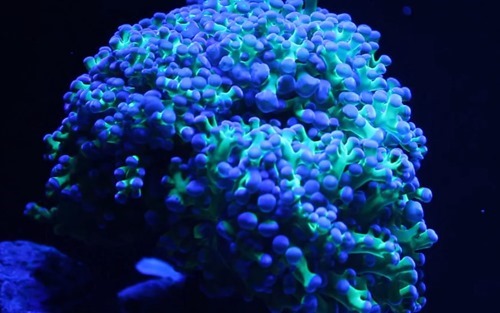
- Type: LPS
- Scientific name: Euphyllia divisa
- Common name: Frogspawn Coral
- Care level: Moderate. Frogspawn corals can be touchy during acclimation, but once acclimated to a tank are usually quite hardy
- Lighting: Moderate to high with careful acclimation
- PAR: 150-200
- Water Flow: moderate non-laminar flow
- Feeding: small meaty foods 1-2 times a week
- Placement: On sand or low on rock work
- Aggressiveness: High. Has long polyp reach with powerful stinging capability, so it needs some space around it
Frogspawn corals are so named because their branching tentacles with light-colored tips look like a mass of frog eggs as you might see in a pond. The tan, brown, or greenish tentacles are extended during the day and sometimes at night.
Frogspawn corals are photosynthetic and while they do not require specific target feeding, they will benefit from occasional feedings of small meaty foods.
As is the case with all stony corals, attention needs to be paid to maintaining proper Calcium and Alkalinity levels in the reef tank for proper skeletal development as noted on the right.
Moon Coral – Favia sp
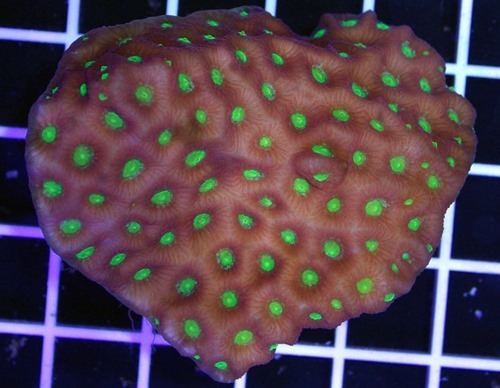
- Type: LPS
- Scientific name: Favia sp
- Common name: Moon Coral
- Care level: Easy. Favia corals are very hardy once acclimated and provided with the proper lighting and water flow
- Lighting: Moderate
- PAR: 100-150
- Water Flow: moderate non-laminar flow
- Feeding:
- Placement: On sand bed or low on rock work
- Aggressiveness: High. Has powerful sting, but relatively short tentacle reach
Favia corals are easy to care for and a good coral choice for beginners and come in unlimited colors to entice the advanced hobbyist.
They like moderate light and will do well under almost any lighting system. If using high powered LED or metal halide, the corals may need to be positioned in a shaded area of the tank.
They also like low to moderate water flow.
Favia corals are photosynthetic but will benefit from an occasional feeding of small meaty foods such as mysis shrimp or cyclopeeze when their tentacles are extended at night.
War Coral – Favites pentagona
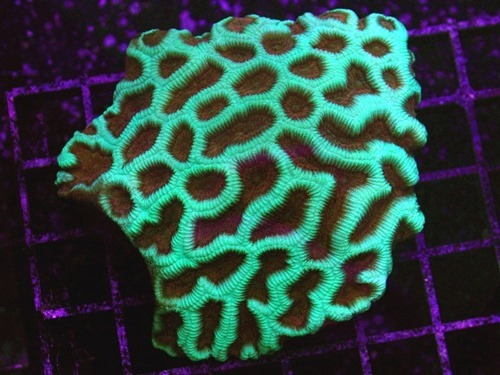
- Type: LPS
- Scientific name: Favites pentagona
- Common name: War Coral
- Care level: Easy. Favia corals are very hardy once acclimated and provided with the proper lighting and water flow
- Lighting: Low to moderate
- PAR: 75-100
- Water Flow: moderate non-laminar flow
- Feeding: small meaty foods 1-2 times weekly
- Placement: On sand bed or low on rock work
- Aggressiveness: Moderate. Has Fairly powerful sting, but relatively short tentacle reach
Favia and the very similar Favites corals are easy to care for and a good coral choice for beginners and come in unlimited colors to entice the advanced hobbyist.
They like moderate light and will do well under almost any lighting system. If using high powered LED or metal halide, the corals may need to be positioned in a shaded area of the tank.
They also like low to moderate water flow.
Favia and Favites coral are photosynthetic but will benefit from an occasional feeding of small meaty foods such as mysis shrimp or cyclopeeze when their tentacles are extended at night.
As is the case with all stony corals, attention needs to be paid to maintaining proper Calcium and Alkalinity levels in the reef tank for proper skeletal development as noted on the right.
Plate Coral – Fungia sp

- Type: LPS
- Scientific name: Fungia sp
- Common name: Plate Coral
- Care level: Easy. Fungia corals are not very demanding
- Lighting: Moderate to fairly intense
- PAR: 150-250
- Water Flow: moderate non-laminar flow
- Feeding: small meaty foods 1-2 times a week
- Placement: On sand bed
- Aggressiveness: Moderate. Does not possess long sweeper tentacles, but may move about on the sand bed a bit, so needs a little space around it
In the wild Plate corals live on the sandy or rocky bottom in moderate to brightly lit locations. They are very undemanding in their requirements and will generally do well in most reef tank environments.
Colors are usually brown, green, orange, or purple and may sometimes have stripes or contrasting colorful edges which are often purple. Other more rare colors include red. Color is generally the most intense under brighter lighting.
Plate corals are photosynthetic but will thrive better and grow faster if fed small meaty foods such as Mysis shrimp on occasion.
Slipper Coral – Polyphyllia sp
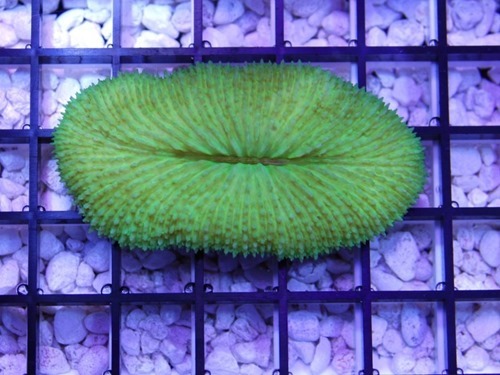
- Type: LPS
- Scientific name: Polyphyllia sp
- Common name: Slipper Coral
- Care level: Easy. Slipper corals are not very demanding
- Lighting: Moderate-high
- PAR: 200-250
- Water Flow: moderate non-laminar flow
- Feeding: small meaty foods 1-2 times a week
- Placement: On sand bed
- Aggressiveness: Moderate. Has strong stinging capability, but does not possess long sweeper tentacles so its reach is short. It may move about on the sand bed, so needs a little space around it
Slipper corals are similar to the more common fungia plate corals but grow in an elongated shape rather than round.
In the wild, slipper corals live on the sandy or rocky bottom in moderate to brightly lit locations.
They are very undemanding in their requirements and will generally do well in most reef tank environments. Colors are usually a shade of brown or green color is generally the most intense under brighter lighting.
Slipper corals are photosynthetic but will thrive better and grow faster if fed meaty foods such as Mysis shrimp on occasion.
As is the case with all stony corals, attention needs to be paid to maintaining proper Calcium and Alkalinity levels in the reef tank for proper skeletal development as noted on the right.
Tooth Coral – Galaxea sp
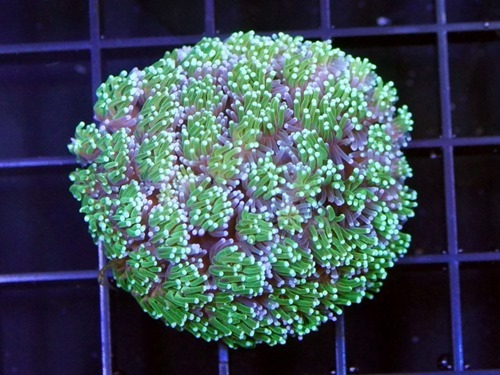
- Type: LPS
- Scientific name: Galaxea sp
- Common name: Tooth Coral
- Care level: Moderate
- Lighting: Moderate
- PAR: 150
- Water Flow: moderate non-laminar flow
- Feeding: small meaty foods 1-2 times weekly
- Placement: On sand bed or low on rock work
- Aggressiveness: High. Has strong stinging capability. Should plan for about 2″ of space between the coral and its neighbors
Galaxea corals have medium size polyps that are most commonly a shade of green, though they are occasionally found in other colors as well.
It requires fairly strong to strong lighting and moderate water movement.
Though primarily photosynthetic, Galaxea corals should also be fed small meaty foods occasionally to maintain their health.
They are aggressive corals with a powerful sting, so they should have at least 2″ of space between them and their nearest neighbors.
Goniopora – Goniopora sp
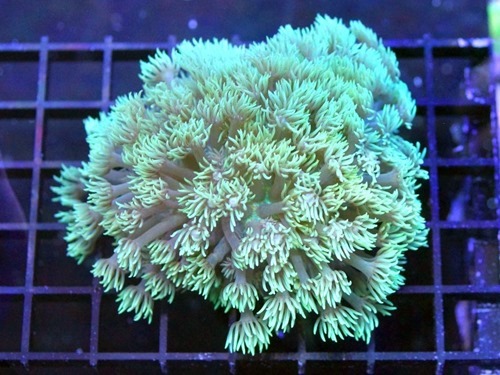
- Type: LPS
- Scientific name: Goniopora sp
- Common name: Goniopora
- Care level: Intermediate to difficult. Long-term success with Goniopora can be difficult, though some hobbyists have maintained colonies in good health for years. Recommended for the more experienced hobbyist
- Lighting: Moderate
- PAR: 100-150
- Water Flow: moderate non-laminar flow
- Feeding: filter feeder foods 1-2 times weekly
- Placement: On sand bed or low on rock work
- Aggressiveness: Moderate. Has long polyp/tentacle reach, but no strong stinging capability
Goniopora come in many different color variations, but are most often found in green, purple, red or blue and often have contrasting oral disc colors. Some species have long polyps that can move rhythmically with the alternating water flow adding a nice since of motion to the aquarium.
Goniopora can be some of the more difficult to care for LPS corals, though many do fine in the home aquarium.
They prefer moderate lighting and moderate water flow which keeps their tentacles gently moving with the current.
Goniopora is not overly aggressive, but some species can have very long tentacle reach, so adequate space must be maintained between itself and neighboring corals. Goniopora can generally touch other Goniopora without incident.
Feeding is usually not required, but they do seem to benefit from occasional feeding of small filter feeder type foods when their tentacles are extended during the day.
Long Tentacled Plate Coral – Heliofungia actiniformis
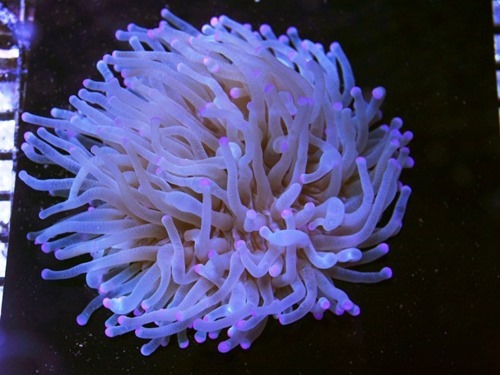
- Type: LPS
- Scientific name: Heliofungia actiniformis
- Common name: Long Tentacled Plate Coral
- Care level: Moderate
- Lighting: Moderate to fairly bright
- PAR: 200
- Water Flow: moderate non-laminar flow
- Feeding: Mysis shrimp several times a week
- Placement: On sand bed
- Aggressiveness: High. Does possess long tentacles with a strong sting, and may move about on the sand bed, so needs some space around it
Long tentacled plate corals are fairly hardy corals that do well under moderate to bright lighting and low to moderate water flow which can be found in most reef tanks.
With their long waving tentacles they are sometimes mistaken for anemones.
It is important to place them on the sand bed and not on the rock work.
They have long tentacles with a powerful stinging capability so they should be placed where they have some space around them. In addition, they are able to inflate their body significantly and float a short distance in the water current, so an eye should be kept on them to ensure that they aren’t encroaching on their neighbors. If this becomes a problem, small rocks can be used to box them in and keep them in place.
Though they are photosynthetic, they should also be fed small meaty foods such as mysis shrimp several times a week to keep them healthy.
Walking Dendro – Heteropsammia cochlea
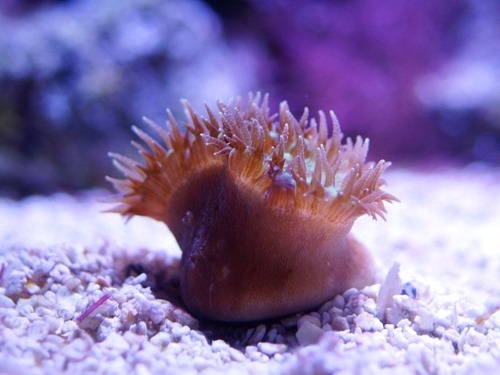
- Type: LPS
- Scientific name: Heteropsammia cochlea
- Common name: Walking Dendro
- Care level: Moderate. The coral itself is pretty undemanding, but the fact that it moves around the tank can lead to trouble with its neighbors
- Lighting: low to moderate intensity
- PAR: 200
- Water Flow: moderate non-laminar flow
- Feeding: Photosynthetic, but fed small meaty foods a couple of times a week. The symbiotic worm needs a sand bed on which to feed
- Placement: Sand bed
- Aggressiveness: Moderate due to ability to move. May sting or be stung by neighbors in the process
Walking Dendro has only been imported since about 2009 in small quantities from Australia.
It leaves unattached from the reef. When young it attaches instead to a sipuculid worm which it eventually grows around until only a small hole remains for the worm to feed on. As the worm moves across the substrate it takes the coral with it.
Walking Dendro is photosynthetic, so does not require target feeding, but it will benefit from occasional feedings of small meaty foods like mysis shrimp. The symbiotic worm finds nutrition in the detritus in the sand bed. Not suitable for bare bottom tanks.
Since they move about, they may come into contact with neighbors that may sting it. The amount of movement varies. They may sit stationary for days or move 8″ or so in a day. If the worm dies, the coral will remain healthy.
Leptastrea – Leptastrea sp
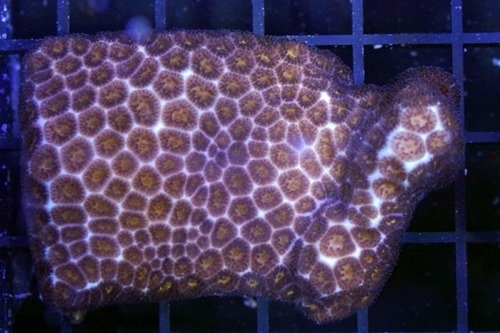
- Type: LPS
- Scientific name: Leptastrea sp
- Common name: Leptastrea
- Care level: Intermediate. Leptastrea corals are typically fairly hardy once acclimated and are relatively non-demanding
- Lighting: low intensity
- PAR: 50-100
- Water Flow: Low to moderate non-laminar flow
- Feeding: small meaty foods 1-2 times weekly
- Placement: On sand bed or low on rock work
- Aggressiveness: Low. Has very short tentacle reach and is slow-growing
Leptastrea corals are not very common in the hobby, but can come in nice colors such as gold, green, orange, and purple and can be a very nice accent piece in the tank. They have small polyps with a delicate look.
They like low light and low to moderate water flow, so they should be kept low in the tank on the sandbed or on the rock work. Some people have been successful in acclimating them to brighter light. Generally, if they are getting bright light, they will not extend their polyps fully and the white skeleton will be visible between the polyps. Under lower light, the polyps fully cover the skeleton.
Some specimens have tiny commensal blue barnacles embedded in them. These barnacles are harmless and can thrive in the reef tank.
They have small polyps and will take small meaty foods.
Brain Coral – Lobophyllia sp
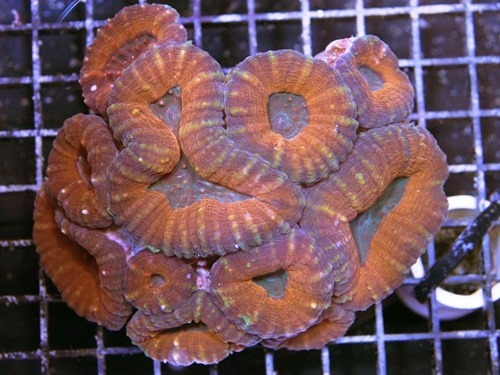
- Type: LPS
- Scientific name: Lobophyllia sp
- Common name: Brain Coral
- Care level: Easy. Lobophyllia corals are hardy once acclimated to their new tank
- Lighting: moderate intensity
- PAR: 150-200
- Water Flow: moderate non-laminar flow
- Feeding: Mysis shrimp once a week
- Placement: On sand bed or low on rock work
- Aggressiveness: Moderate. Has short tentacle reach
Lobophyllia corals are fairly easy to maintain and are suitable for most types of reef tanks.
They do well with lighting that is moderate in intensity but can also be acclimated to fairly intense lighting as well.
They like moderate water flow and should be kept out of direct high current water flow
They are photosynthetic and do not require direct feeding, but they do benefit from occasional feedings of small meaty foods during the evening when its tentacles are visible.
Acan Lord – Acanthastrea lordhowensis
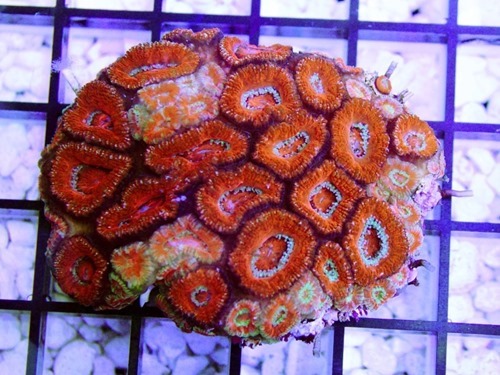
- Type: LPS
- Scientific name: Acanthastrea lordhowensis
- Common name: Acan Lord
- Care level: Easy. This is a fairly hardy coral and will adapt to many conditions
- Lighting: Low to moderate
- PAR: 50-100
- Water Flow: Low to moderate flow
- Feeding: mysis shrimp 1-2 times weekly
- Placement: On live rock or sandbed
- Aggressiveness: Low. Short tentacles extended at night. Can safely touch other Acan colonies
Acans Lords are excellent candidates for low-moderate light reef aquariums or areas with moderate lighting.
There are many different color variations and they appear with impressive displays of color under blue reef lights.
Although feeding is not required, Acans will grow quicker if they are target fed meaty foods on occasion when their tentacles are extended at night.
You should give your attention to maintain proper Calcium and Alkalinity levels in the reef tank for the proper skeletal development of these corals
Micromussa sp
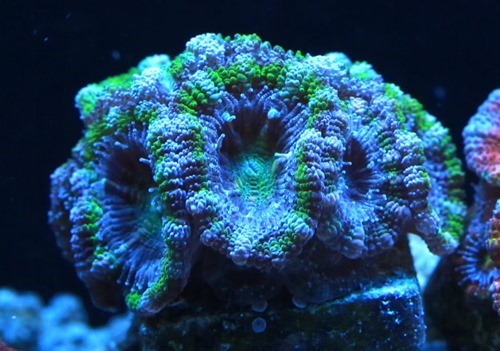
- Type: LPS
- Scientific name: Micromussa sp
- Common name:
- Care level: Easy. This is a fairly hardy coral and will adapt to many conditions
- Lighting: Low
- PAR: 50-75
- Water Flow: low to moderate non-laminar flow
- Feeding: feed small meaty foods 1-2 times weekly
- Placement: Low on live rock or sandbed
- Aggressiveness: moderate. Short tentacles extended at night
Micromussa look similar to Acan Lords, but in miniature form and they are much less common in the hobby than the Acans. Their care requirements are very similar to Acans and are often found in the same areas on a reef.
Micromussa are excellent candidates for moderately lit reef aquariums or low to moderately lit areas of reef aquariums with bright lighting.
They come in many different color variations, usually with red, green, or purple and often multicolored.
Micromussa do best and will grow quicker if they are fed small meaty foods or large filter feeder foods on occasion such as small brine shrimp when their tentacles are extended at night.
Cup Coral – Mycedium sp
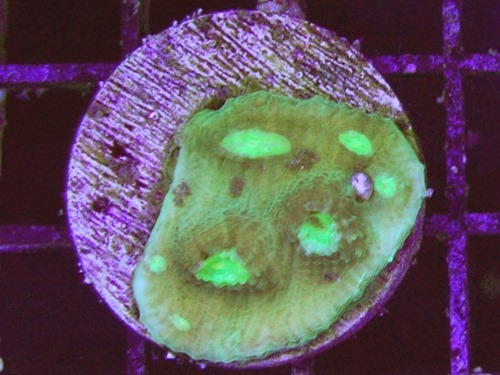
- Type: LPS
- Scientific name: Mycedium sp
- Common name: Cup Coral
- Care level: Intermediate. This is one of the more hardy chalice corals and will adapt to many conditions
- Lighting: Low to Moderate
- PAR: 75-150
- Water Flow: moderate non-laminar flow
- Feeding: small Mysis shrimp, cyclopeeze, and oyster eggs weekly
- Placement: Low on live rock
- Aggressiveness: Low. Tentacles extended at night
Mycedium corals are one of the families of corals commonly referred to as Chalice corals. Mycedium can be recognized by the fact that the polyps always face outwards toward the edge of the colony and typically grow in a cup shape, hence the common name of Cup Coral.
Pectinia sp
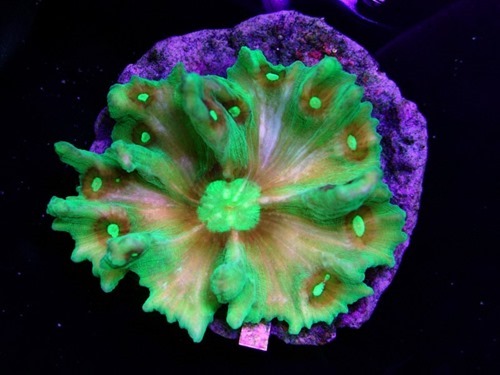
- Type: LPS
- Scientific name: Pectinia sp
- Common name:
- Care level: Moderate. Pectinia coral are somewhat delicate and should be acclimated to new lighting carefully
- Lighting: low to moderate intensity
- PAR: 100
- Water Flow: moderate non-laminar flow
- Feeding:
- Placement: Low on rock work
- Aggressiveness: Low. Has short tentacle reach
Pectinia corals generally have an interesting growth form with upwards growing spires rising from a base.
Colors are typically muted browns and greens but occasionally are found in other interesting colors and patterns that can be quite attractive and highly collectible.
Pectinia corals are not very demanding overall but should be kept under low to moderate lighting to prevent bleaching unless carefully acclimated.
Maze Coral – Platygyra sp
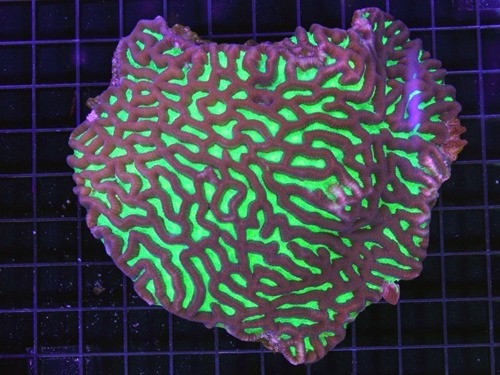
- Type: LPS
- Scientific name: Platygyra sp
- Common name: Maze Coral
- Care level: Intermediate. Platygyra are one of the more delicate families of brain corals, but they are still typically fairly hardy once acclimated and provided with the right lighting and water flow
- Lighting: moderate intensity
- PAR: 100-150
- Water Flow: moderate non-laminar flow
- Feeding: small meaty foods twice a week
- Placement: Low on rock work
- Aggressiveness: Moderate to high. Extends long sweeper tentacles at night, so will need some space around it
Platygyra are one of the many corals sometimes referred to as Brain corals. They can usually be recognized by the fact that their corallites form maze-like channels across the coral.
Colors may include brown, green, red, white, gray, and purple
They like moderate light and will do well under almost any lighting system. If using high powered LED or metal halide, the corals may need to be positioned in a shaded area at the bottom of the tank.
They also like low to moderate water flow.
Platygyra corals are photosynthetic but will benefit from an occasional feeding of small meaty foods such as mysis shrimp or Cyclopeeze when their tentacles are extended at night. Some Platygyra have extremely long sweeper tentacles extended at night, so keep this in mind when placing the coral.
Bubble Coral – Plerogyra sinuosa
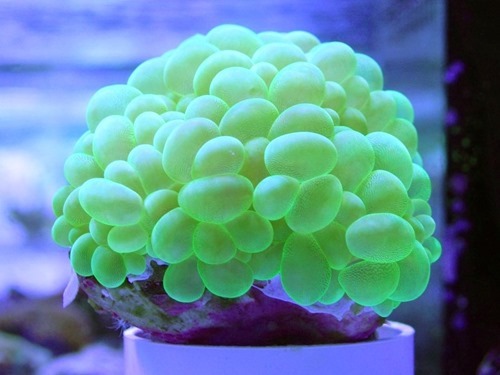
- Type: LPS
- Scientific name: Plerogyra sinuosa
- Common name: Bubble Coral
- Care level: Easy. Bubble corals are very hardy once acclimated
- Lighting: Moderate
- PAR: 150
- Water Flow: moderate non-laminar flow
- Feeding: Mysis shrimp once a week
- Placement: On sand bed or rock work
- Aggressiveness: High. Has moderate tentacle reach with powerful stinging capability, so it needs some space around it
Bubble corals are one of the easier to keep LPS corals.
They do not like strong lighting, so in brightly lit tanks, place in a location with low to moderate lighting
Bubble corals also do not like strong water flow as they find it difficult to inflate their bubbles, so should be placed in a location to moderate water-flow so that they can fully expand their tentacles.
They will benefit from a weekly feeding of small meaty foods such as mysis shrimp.
Scoly – Scolymia australis
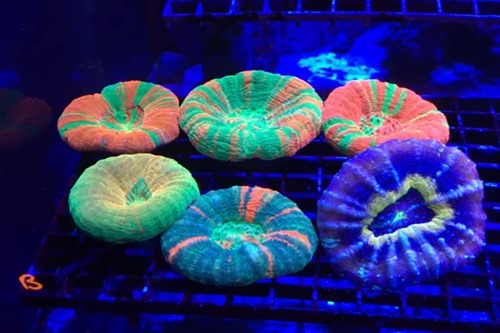
- Type: LPS
- Scientific name: Scolymia australis
- Common name: Scoly
- Care level: Easy to moderate. Long-term survival is improved if the corals are fed meaty foods like mysis shrimp once a week
- Lighting: moderate intensity
- PAR: 100-150
- Water Flow: moderate non-laminar flow
- Feeding: Mysis shrimp 1-2 times weekly
- Placement: On sand bed
- Aggressiveness: Moderate. Has short tentacle reach but can expand in size and has a fairly powerful sting
Scoly corals are solitary fleshy single-polyp corals that do well in most home reef tanks.
Color is usually a solid green or red but may include multiple colors such as purple, black, white, or orange which radiate like spokes on a wheel. The color has a significant impact on the price with the most unusual or colorful specimens commanding the highest prices.
Scoly corals do well under moderate lighting and low to moderate water flow and should be placed on the sand bed.
Though primarily photosynthetic, feeding tentacles are extended at night and the coral will do best if feed small meaty foods such as mysis shrimp 1-2 times weekly when the tentacles are extended.
As is the case with all stony corals, attention needs to be paid to maintaining proper Calcium and Alkalinity levels in the reef tank for proper skeletal development as noted on the right.
Brain Coral – Symphyllia
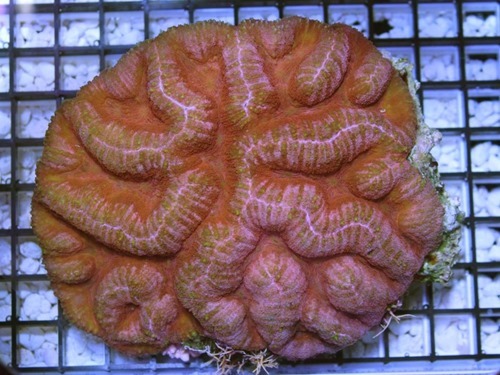
- Type: LPS
- Scientific name: Symphyllia
- Common name: Brain Coral
- Care level: Easy. Symphyllia corals are hardy once acclimated
- Lighting: Moderate
- PAR: 150-200
- Water Flow: moderate non-laminar flow
- Feeding:
- Placement: On sand bed or low on rock work
- Aggressiveness: Moderate. Has relatively short tentacle reach. Can grow large so needs some space around it
Symphyllia corals are hardy corals and a good choice for beginners as well as advanced hobbyists.
They grow in a flat or mounding shape and can grow quite large, though growth is usually fairly slow. Colors are usually solid red, green or brown often with contrasting oral discs. Other colors such as purple, white and pink are also sometimes found.
They like moderate lighting and low to moderate water flow which makes them suitable for most reef tanks.
Feeding is not required, but they will take small meaty foods at night when their tentacles are extended.
Folded Brain Coral – Trachyphyllia geoffroyi
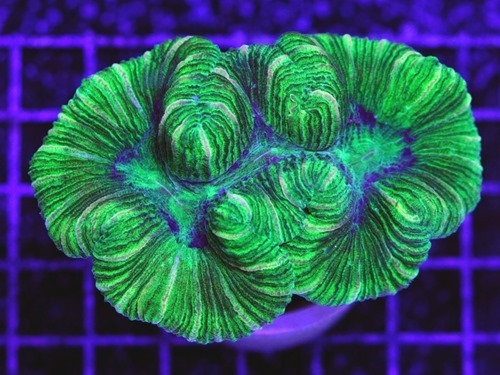
- Type: LPS
- Scientific name: Trachyphyllia geoffroyi
- Common name: Folded Brain Coral
- Care level: Easy. Trachyphyllia corals are fairly hardy once acclimated
- Lighting: Moderate
- PAR: 100-150
- Water Flow: moderate non-laminar flow
- Feeding: small meaty foods 1-2 times weekly
- Placement: On sand bed
- Aggressiveness: Moderate. Has short tentacle reach and will generally lose in any fit with another coral
Trachyphyllia corals are hardy, easy to care for corals.
They like moderate lighting and low to moderate water flow and will do well even under low lighting. Normal placement is on the sand bed.
They do not require feeding, but they do appreciate occasional meals of small meaty foods at night when their tentacles are out.
As is the case with all stony corals, attention needs to be paid to maintaining proper Calcium and Alkalinity levels in the reef tank for proper skeletal development as noted on the right.
Sun Coral – Tubastrea aurea
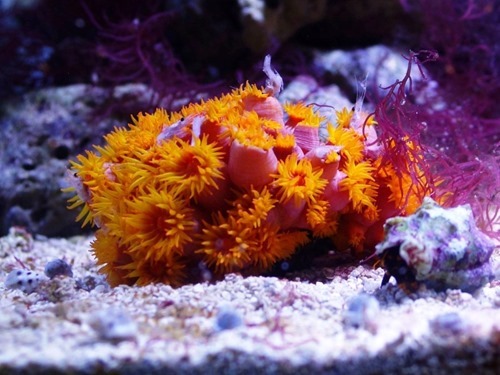
- Type: LPS
- Scientific name: Tubastrea aurea
- Common name: Sun Coral
- Care level: Moderate. Sun corals are hardy as long as their feeding requirements are met. It is due to the requirement to target feed the coral that it is listed as moderate
- Lighting: low intensity
- PAR: 25-100
- Water Flow: moderate non-laminar flow
- Feeding: Mysis shrimp approximately 3-4 times a week
- Placement: On sand bed or low on rock work
- Aggressiveness: High. Has short tentacle reach, but strong stinging capability
Sun corals are normally closed during the day and extend their polyps at night to feed. After becoming accustomed to their new home and feeding regimen, they may start to show their polyps during the day as well
Sun corals are not photosynthetic and therefore require frequent feeding of frozen or fresh meaty foods such as mysis shrimp, krill, or brine shrimp. They should be fed heavily at least twice a week or lighter feedings may be given up to every day. Since the polyps do not share nutrition, each of the polyps should be fed at least on occasion.
Since they are not photosynthetic, they can be placed in an area of low light in the aquarium, preferably under a ledge or in a cave in an area of low water flow.
They should be placed on a rock which is then placed on the sand. They will cover their tissue if there is a danger.
Pipe Organ Coral – Tubipora musica
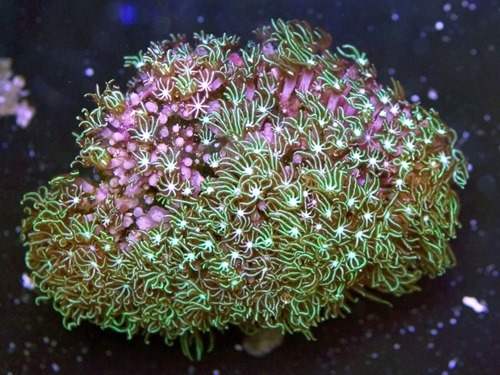
- Type: LPS
- Scientific name: Tubipora musica
- Common name: Pipe Organ Coral
- Care level: Moderate
- Lighting: Moderately bright
- PAR: 350
- Water Flow: moderately strong flow
- Feeding: filter feeder foods 2-3 times a week
- Placement: On sand bed or low on rock work
- Aggressiveness: Low. Has no significant stinging capability and does not appear to wage chemical warfare with neighbors. It is also not invasive
The Pipe Organ Coral is a soft coral but is often classified as a stony coral because of its red calcareous skeleton which is often dried and sold as curios, unfortunately. Each polyp forms a long individual tube or pipe. The tubes are cemented together at points by horizontal plates. The tubes resemble a pipe organ which gives it the common name.
The color of the polyps may be a shade of brown/green or gray. When its polyps are open it looks similar to Green Star Polyp corals, but it is not invasive like the Star Polyps can be.
It requires fairly strong water flow and lighting and can do well in SPS dominate tanks.
It is photosynthetic and does not need to be fed, but may feed on small filter feeder foods in the water column.
Because it builds a calcareous skeleton, it requires good calcium and alkalinity levels similar to stony corals.
Pagoda Coral – Turbinaria reniformis
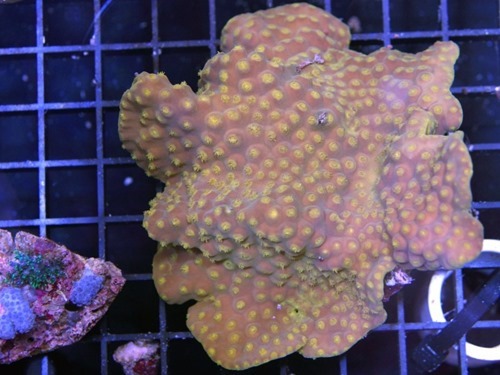
- Type: LPS
- Scientific name: Turbinaria reniformis
- Common name: Pagoda, Turban, Vase, or Scroll coral
- Care level: Easy. Tubinaria corals are fairly hardy once acclimated
- Lighting: Moderate
- PAR: 150-200
- Water Flow: moderate non-laminar flow
- Feeding: small meaty foods 1-2 times a week
- Placement: On sand bed or low on rockwork
- Aggressiveness: Low. Does not possess sweeper tentacles
Scroll coral may grow in a scroll, cup, or whorl shape depending on water and lighting conditions. Under lower light, they tend to grow in more of a plating fashion. Color may vary from almost brown to bright yellow.
Care level is fairly easy to moderate depending on the origin of the coral. Wild corals with a flatter and thicker growth form tend to be hardier than those with intricate scrolling and thin branches
Scroll coral will benefit from occasional feedings of smaller meaty foods or filter feeder foods. Under good conditions, it is a fairly fast grower.

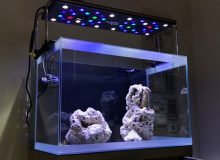
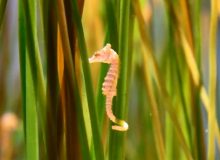
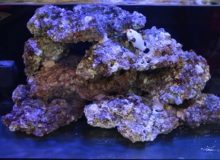
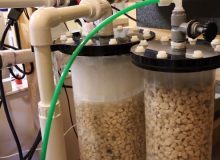
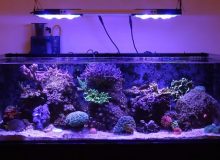
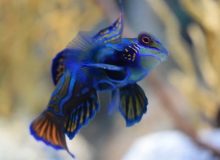
Leave a Reply